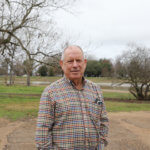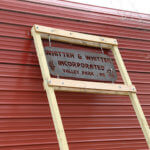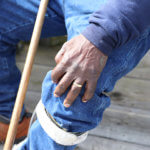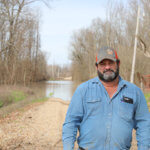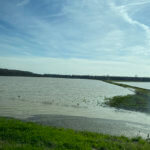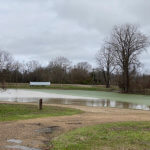In 2019, more than 1.5 million acres of land in Mississippi experienced flooding, affecting farmers and ranchers, wildlife, business owners and the everyday citizen in numerous ways. Roads, forests and fields stayed covered with water for months, preventing families from returning to their homes, pushing wildlife from their habitats and keeping farmers from planting a single seed.
Despite the destruction so many Mississippians faced, they are walking through 2020 with optimism.
“I’m definitely planning on farming this year,” says Billy Whitten, a corn and soybean farmer in Issaquena County. “I don’t think we could stand another year of nothing like we had last year.”
Waye Windham, another row crop farmer who calls the south Delta home, is doing everything in his power to make sure he gets to plant and harvest a crop this year.
“I anticipate planting,” Windham says. “But, I did last year, too. So, we’ll just have to see. We just have to hope for the best and stay positive.”
Windham typically plants and harvests 2,000 acres each year. In 2019, he considered himself lucky to have planted 500 acres.
“There were a lot of people who didn’t get to plant any,” he says. “My house didn’t go under water, but a lot of people’s did. There were a lot of people way worse off than me.”
Whitten, along with his son Brad, were two of the farmers who did not get to plant anything.
“We typically farm 1,440 acres and didn’t plant the first acre last year,” Whitten says. “Normally, we start getting our land ready to plant as soon as we’re finished harvesting. But, we didn’t get to do that in the fall of ’18. It started raining about the time we finished harvesting our crops, and then it just never did dry up. I didn’t get on a tractor until the end of August ’19 to start getting ready for this year. I should have been pulling a grain cart and harvesting corn and soybeans at that time.”
The flood of 2019 not only affected how farmers make a living, it impacted how citizens live.
Anderson Jones, a small farmer who was born and raised in the south Delta, was displaced from his home for more than four months last year.
“In February, I sent my wife and daughter to live with family in Vicksburg because you could only get to the house by boat,” Jones says. “My son and I stayed behind. We had some sandbags put around the house. On May 19, at two o’clock in the morning, I went down the hall checking on things, and the water was coming through the hallway. We couldn’t stop it, so we had to walk through the water to the end of the road to the car to get out.”
From May to August, Jones boated several miles every day to check on his home. When the water finally receded, he gutted his entire house.
“I was born and raised in that house,” he says. “I ain’t about to tear it down or nothing like that. I went through this back in ’73 and years since then. We been fighting [for a solution to the flooding] for a long time. We’ve just got to keep on fighting because this is our home.”
Tracey Harden, owner of Chuck’s Dairy Bar in Rolling Fork, felt the impact of the continuous flooding in not only her home, but also her business.
“We make most of our money during planting, harvest and hunting seasons,” Harden says. “The flooding affected all three of those areas with the shortage of orders coming in. Many of my employees’ husbands were not able to work much because of the farms not being able to hire, so they were all looking to pick up extra hours. It was hard to keep up with it all because you want to help them, but you also want to keep the business open.”
The impact of the flooding on Mississippi’s rural communities has been enormous and will continue to linger for years to come, according to Windham.
“We’re a farming community, which means pretty much everything is connected to the farmer,” Windham says. “If farmers are making money, they’re not spending money. This affects our grocery stores, parts stores, restaurants, furniture stores, equipment dealerships, chemical businesses, and even the banks. It has a domino effect. You may think it won’t touch you, but in the end, somehow, it will.”
Forty-one percent of the continental United States drains down the Mississippi River to the Gulf of Mexico, according to the Mississippi Levee Board. Because of this, Congress issued the Yazoo Backwater Project in the Flood Control Act of 1941. The plans for the Yazoo Backwater Project included four major components – levees, a connecting channel, drainage structures and pumps – be completed to project the land along the Mississippi River in the south Delta. Since issuing the Yazoo Backwater Project plans, the levees, connecting channel and drainage structures were completed.
Unfortunately, the Yazoo Backwater Project pumps have yet to be installed. In 2008, the Environmental Protection Agency vetoed the Yazoo Backwater Project under the authority of the Waters of the United States rule, halting any proceedings to install the pumps.
If installed now, the Yazoo Backwater Project pumps would cost approximately $220 million and take four years to complete. The Mississippi Levee Board predicts more than $372 million in damage would have been prevented from 2008 to 2018 if the pumps had been in place.
“We’ve got to keep sticking together,” Whitten says. “The grain elevator at Valley Park is kind of a hangout for us farmers. We always solve the world’s problems down there. We share information with each other and offer advice. It’s important for us to do that so we can keep fighting.”
Harden agrees with Whitten’s sediment, saying citizens of the south Delta must continue to stick together to fight for what is right.
“At the end of the day, we’re all different, but this little town comes together so well to help each other out no matter what,” she says. “It’s just overwhelming the love and support we’ve seen from strangers. We are all so much stronger when we stick together as one.”


